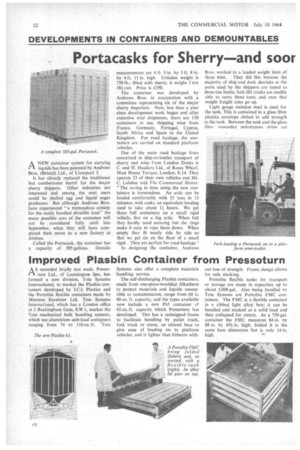Portacasks for Sherry—and soor
Page 34

Page 35

If you've noticed an error in this article please click here to report it so we can fix it.
Dr Sugar ?
ANEW container system for carrying liquids has been patented by Andrews Bros. (Bristol) Ltd., of Liverpool 3.
It has already replaced the traditional but cumbersome barrel for the major sherry shippers. Other industries are interested and among the next users could be shelled egg and liquid sugar producers. But although Andrews Bros. have experienced " a tremendous anxiety for the easily handled divisible load" the many possible uses of the container will not be considered fully until late September, when they will have completed their move to a new factory at Aintree.
Called the Portacask, the container has a capacity of 585 gallons. Outside
measurements are 6 ft. 9 in. by 3 ft. 8 in. by 4 ft. 11 in high. Unladen weight is 750 lb.; filled with sherry, it weighs 2 ton 18i cwt. Price is £390.
The container was developed by Andrews Bros. in conjunction with a committee representing six of the major sherry importers. Now, less than a year since development work began and after extensive trial shipments, there are 150 containers in use, shipping wine from France, Germany, Portugal, Cyprus, South Africa and Spain to the United Kingdom. For road haulage, the containers are carried on standard platform vehicles.
One of the main road haulage firms concerned in ship-to-bottler transport of sherry and wine from London Docks is
C. and Hauliers Ltd., of Roses Wharf, Mast House Terrace, London, E.I4. They operate 23 of their own vehicles and Mr. C. Labdon told The Commercial Motor: "The saving in time using the new containers is tremendous. An artic can be loaded comfortably with 15 tons in 15 minutes; with casks, an equivalent loading used to take about 11 hours. We get three full containers on a small rigid vehicle, five on a big attic. When full they hardly need securing but the rings make it easy to rope them down. When empty they fit neatly side by side so that we get six on the floor of a small rigid. They are perfect for road haulage."
In designing the container, Andrews Bros. worked to a loaded weight limit of three tons. They did this because the majority of ship and dock derricks at the ports used by the shippers are tested to three-ton limits; fork-lift trucks are readily able to carry three tons; and over that weight freight rates go up.
Light gauge stainless steel is used for the tank. This is contained in a glass fibre plastics envelope ribbed to add strength to the tank. Between the tank and the glass fibre expanded polystyrene strips act
as temperature insulation and a protective cushion for the tank. For easy handling there are galvanized steel channels within the base for fork lifting and four "eyes" are provided on the top for crane lifting. For stability when stacked, four concave recesses in the base of each container correspond to convex projections on the top, for non-shift "seating ".
At the top of the container is a 3-in.bore combined filling point and guide tube for dipstick, on an 18-in.-diameter bolted-on cover which may be removed for access. This entire assembly has a glass fibre cover secured with locks to comply with customs requirements.
The base of the tank itself has a 1+ in. fall to a sump fitted with a screwed plug (which can be released only through the top for complete safety of a locked-up load) for washing out purposes.
Any concern that the departure from the traditional carrying of wine in the wood might affect the taste has been dispelled by wine expert H. W. Berg, a professor of Viticulture and Enology.
The sherry shippers have found that the Portacask can be shipped from Spain to England and returned empty for less than the single journey of an equivalent. quantity in barrels.
























































































































